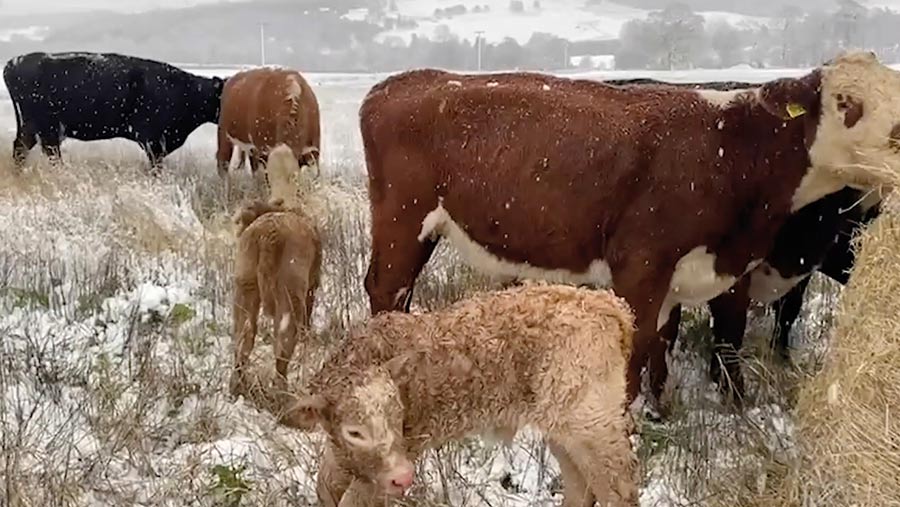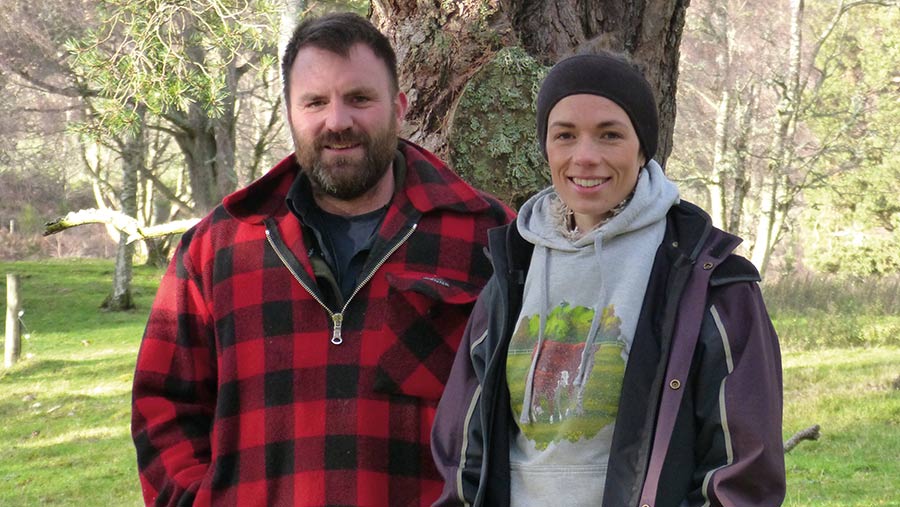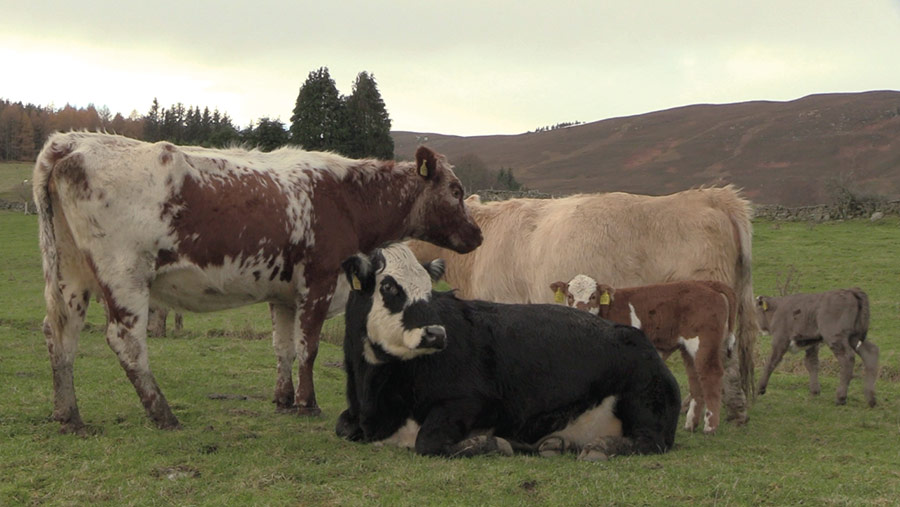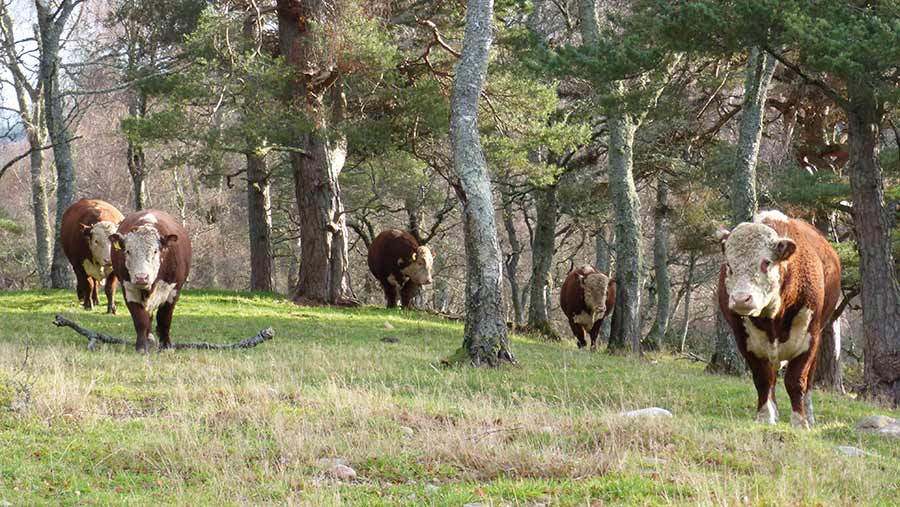Video: New entrants harness hills with £106 a cow winter feed cost
 © Ian Christie
© Ian Christie A young family owes a debt of thanks to an open-minded landlord and a small and hardy cow type that thrives on rough Cairngorm hill country.
Without the faith of Clare Carson at the Inchmarnoch Estate, Aberdeenshire, Ian and Rachel Christie would not have had a chance of farming the challenging area east of Ballater and cutting their teeth as suckler farmers.
See also: Suckler unit trials outwintering lighter cows in bid to reduce costs
But the opportunity was seized by the Christies, who made the most of rocky hill park, rough grazing and heather hill. Their low-input system has been a rare testing ground for Hereford and Hereford-cross suckler cows.
The system treats cows much like hill sheep. They must get in calf, calve and winter outside, with winter supplementation provided by energy blocks and haylage.
After 11 years, the result is a genetic package that has got some of the UK’s leading commercial farmers interested, allowing the Christies to diversify into bull sales.
Watch the video and read the full report below.
Farm facts: Ballaterach, Ballater, Aberdeenshire
- 150 cross-bred suckler cows including 22 pedigree Herefords (Ruach prefix)
- 550 Romney cross Cheviot ewes
- Farming more than 1,220ha (3,000 acres) as well as grazing licences
- Home tenanted farm is mostly rough heather hill with 80ha (200 acres) of workable lowland ground and 160ha (400 acres) of hill park
- Mortgage being paid on a 62ha (155 acres) lowland farm
- Charolais terminal sires
Getting started

Ian and Rachel Christie © MAG/Michael Priestley
Opportunity knocked when the couple were students at SRUC Craibstone. Mr Christie was living in a caravan when he saw the tenancy advertised, and took a chance to follow his grandfather and uncle into farming.
With “fag-packet” figures on a small flock of sheep, he put together a business plan for a sheep and suckler herd at Ballaterach, and submitted a bid to the estate.
They applied for a £50,000 loan (to buy sheep) through the Enterprise Finance Guarantee Scheme, which saw risk split 75:25 between the Scottish Government and the bank.
In the early years Mr Christie’s shearing and shepherding raised cash to buy cows.
They now have three children – Ian, Lily and Charis – a fencing business, Christie Fencing, founded in 2016 and employing 15 full-time staff, and a mortgage on a nearby farm, Blackhills.
Herd building

© MAG/Michael Priestley
Numbers have grown from 15 cows and 200 sheep in 2011 to 150 cows due to calve in 2023 and 550 sheep.
“We are probably optimal for cow numbers now for the land we have access to,” Mrs Christie says. “I have the children and can check the cows each day, and Ian’s farming time only amounts to two days a week.
“We have to drive round and check the cows a lot, but Ian’s dad is a big help in checking cows and putting energy blocks out.”
Cows were sourced from Thainstone in-calf or with calves at foot, and through a veterinary surgeon friend who deals in cattle.
Calving is in two blocks. The challenging terrain means creep feeding of calves is not practical, so spring-born heifers from one block calve down in the autumn block at two-and-a-half years.
About 2.5km of fencing has been done each year, so Ballaterach is now well fenced, and low-lying land at Blackhills is subdivided into 3ha (7.4-acre) blocks with a central track, allowing better grass management for youngstock and sheep.
Drop-outs
Some dairy crosses and natives have given 8-10 calves on the system. One of the first cows they bought left the farm this year as a 14-year-old.
But not all cows cope with the conditions and are barren come autumn, explains Mrs Christie. Larger dairy-cross and continental-cross cows typically struggle, although income from fleshy cull cows has been important for cash flow.
After weaning, barrens are fed for 30-60 days on a loose-housed, straw-bedded system and given draff (£40/t) and biscuit meal (£314/t), mixed 2:1 for a combined cost of £131/t, as well as haylage, both ad-lib. They are sold in the new year.
Selection criteria
The Christies have found how to choose cows that work with their situation:
- Moderate size 500-600kg
- Moderate milk If she is too milky and sacrifices herself for her calf too much she will lose condition and will not hold to the bull in 10 weeks
- Deep and gutty A large rumen for foraging roughage
- Short, strong legs Mountainous ground reveals structural weaknesses in cows
- Native and easy fleshing Herefords have worked well on the farm, as have Black Baldies and other native crosses
- Breeder is important Line One Herefords were bought from the Douglas family at Ervie Herefords, Stranraer.
Winter costs

Three bulls have been sold to leading commercial farmers © MAG/Michael Priestley
Cows are moved to deferred hill park and rough hill in November to winter for 12 weeks before moving back home to Ballaterach to calve in bye.
Snow can be deep, but cows will dig and graze through 25cm of snow, although bales must be supplemented when the snow is frozen with a hard cap.
The farm has two other blocks. Blackhills is used for growing and finishing animals, with wintering autumn calvers and weaned cattle on bale grazing and kale.
Another unit, 14 miles away with good in-bye ground and extensive rough grazing, will be used to winter a mob of 55 spring-calving cows with followers.
An opportunity crop of large-bale silage was harvested here to take these through to calving.
Feed costs for the Christies’ cows |
||
|
Feed |
Cost |
Comments |
|
Sheep/cattle high-energy and rumen-degradable protein feed block. One block does 20 cows for two days |
£701/t with 11.41t used on cattle = £8,000
|
Blocks are easy to put in the back of a pick-up and place on hill areas to supplement rough grazing |
|
Better silage is aimed at youngstock and sheep, and bulkier stuff is ideal for cows. This is budgeted at 12 weeks through winter and 12 weeks through calving to spring, and for transitioning cows onto spring grass |
Production of 14-15 bales/ha (six bales/acre) on better ground means contractor costs are high at £40 a bale this year. A winter budget of 100 bales for 150 cows costs £8,000 |
Cows are given a bale when their rumens (triangle on left side) are empty. Winter bales are put in place and made near the wintering ground to avoid too much travel. About 1 .5 bales gets a cow through a typical winter |
|
Total cost |
£106 a cow (could be lower if the winter is mild and not snowy) |
This does not include time, ground rent, pick-up depreciation or diesel |
Future plans
- Finish more steers and sell more direct Five have been slaughtered this year. A 300kg carcass at £12/kg average is a good diversification
- Make more of the heather hill The Christies plan to fence and subdivide a 323ha (800-acre) heather plateau to open the hill to their cows. Fencing is essential as they can wander 12 miles
- Sell more bulls and grow Ruach Herefords Jamie Leslie, a leading commercial farmer at Scholland farm, Shetland, has had great performance from one bull, while two bulls were delivered to regenerative pioneer Alex Brewster at Rotmell Farming, Perthshire, this winter.
